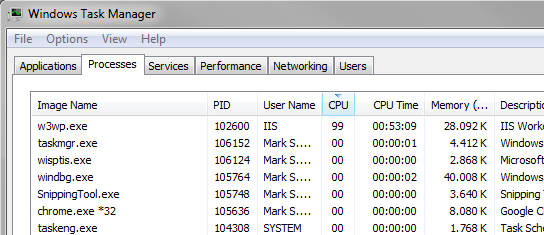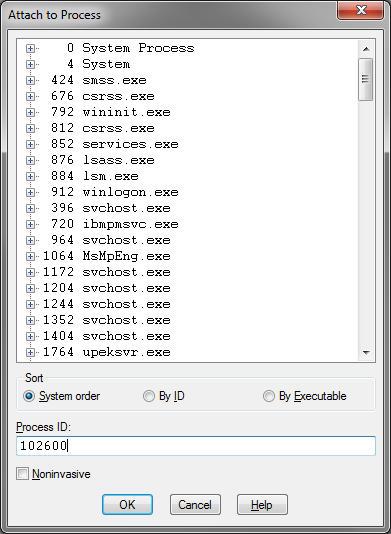When your w3wp process is stuck at 100% like, like when I used a non-thread-safe Dictionary concurrently, you may want to identify what request the runaway thread is actually serving. Let me show you how to identify which request caused a runaway thread, using windbg.
First you’ll want to identify the process ID (PID) of the w3wp process. In my case, that’s 102600:
Next you’ll want to start up Windbg (make sure to use the correct bitness (x86 vs x64) that corresponds to the bitness of your process). Once started, press F6 to open up the Attach to Process dialog. Once open, enter your process ID and click OK.
Doing so should bring up the Command window, ready for your command:
As the first thing, start out by loading the Son of Strike extension, allowing us to debug managed code.
0:039> .loadby sos clr
Then continue by running the !runaway command to get a list of runaway (basically threads using lots of CPU) threads:
0:039> !runaway
User Mode Time
Thread Time
20:14930 0 days 0:21:44.261
21:15204 0 days 0:21:00.878
27:19d48 0 days 0:04:23.860
32:18748 0 days 0:02:59.260
31:18bcc 0 days 0:02:19.277
30:19d80 0 days 0:01:44.083
25:19ec0 0 days 0:01:32.446
24:16534 0 days 0:01:31.135
29:19a80 0 days 0:01:08.297
23:19110 0 days 0:00:30.591
6:19b40 0 days 0:00:00.109
26:18a14 0 days 0:00:00.015
0:19dcc 0 days 0:00:00.015
39:16fa8 0 days 0:00:00.000
...
Threads 20 & 21 seem to be the interesting ones. Let’s start out by selecting thread #20 as the active thread:
0:039> ~20s
000007fe`913a15d9 3bc5 cmp eax,ebp
Once selected, we can analyze the stack and its parameters by running the !CLRStack command with the -p parameter:
0:020> !CLRStack -p
OS Thread Id: 0x14930 (20)
Child SP IP Call Site
000000000dccdb00 000007fe913a15d9 System.Collections.Generic.Dictionary`2[[System.Int16, mscorlib],[System.__Canon, mscorlib]].FindEntry(Int16)
PARAMETERS:
this = <no data>
key = <no data>
000000000dccdb50 000007fe913a14c0 System.Collections.Generic.Dictionary`2[[System.Int16, mscorlib],[System.__Canon, mscorlib]].get_Item(Int16)
PARAMETERS:
this = <no data>
key = <no data>
000000000dccdb80 000007fe91421cbb iPaper.BL.Backend.Modules.Languages.LanguageCache.GetLanguageByID(Int32, iPaper.BL.Backend.Infrastructure.PartnerConfiguration.IPartnerConfig) [e:\iPaperCMS\BL\Backend\Modules\Languages\LanguageCache.cs @ 44]
PARAMETERS:
languageID (0x000000000dccdc20) = 0x0000000000000001
partnerConfig (0x000000000dccdc28) = 0x00000000fffc3e50
000000000dccdc20 000007fe91421dfa iPaper.BL.Backend.Modules.Languages.Language.GetFontFileForLanguage(Int32, iPaper.BL.Backend.Infrastructure.PartnerConfiguration.IPartnerConfig) [e:\iPaperCMS\BL\Backend\Modules\Languages\Language.cs @ 37]
PARAMETERS:
languageID (0x000000000dccdc70) = 0x0000000000000001
partnerConfig (0x000000000dccdc78) = 0x00000000fffc3e50
000000000dccdc70 000007fe91417400 iPaper.Web.FlexFrontend.BL.Common.CachedUrlInformation.GetFromUrlDirectoryPath(System.String, System.String, iPaper.BL.Backend.Infrastructure.PartnerConfiguration.IPartnerConfig) [e:\iPaperCMS\Frontend\BL\Common\CachedUrlInformation.cs @ 89]
PARAMETERS:
url (0x000000000dccde80) = 0x00000003fff27e30
host (0x000000000dccde88) = 0x00000003fff29618
partnerConfig (0x000000000dccde90) = 0x00000000fffc3e50
000000000dccde80 000007fe91417576 iPaper.Web.FlexFrontend.BL.Common.CachedUrlInformation.GetFromHttpContext(System.String, System.Web.HttpContext, iPaper.BL.Backend.Infrastructure.PartnerConfiguration.IPartnerConfig) [e:\iPaperCMS\Frontend\BL\Common\CachedUrlInformation.cs @ 122]
PARAMETERS:
paperPath (0x000000000dcce010) = 0x00000003fff27e30
context (0x000000000dcce018) = 0x00000000fffa6040
partnerConfig (0x000000000dcce020) = 0x00000000fffc3e50
000000000dcce010 000007fe91415529 iPaper.Web.FlexFrontend.BL.RequestHandler.RequestHandler.loadFrontendContext(System.String) [e:\iPaperCMS\Frontend\BL\RequestHandler\RequestHandler.cs @ 469]
PARAMETERS:
this (0x000000000dcce260) = 0x00000000fffa9590
paperPath (0x000000000dcce268) = 0x00000003fff27e30
000000000dcce260 000007fe91414b73 iPaper.Web.FlexFrontend.BL.RequestHandler.RequestHandler.context_PostAcquireRequestState(System.Object, System.EventArgs) [e:\iPaperCMS\Frontend\BL\RequestHandler\RequestHandler.cs @ 95]
PARAMETERS:
this (0x000000000dcce5f0) = 0x00000000fffa9590
sender (0x000000000dcce5f8) = 0x00000000fffa8a50
e (0x000000000dcce600) = 0x00000000fffaebb0
000000000dcce5f0 000007fedb72c520 System.Web.HttpApplication+SyncEventExecutionStep.System.Web.HttpApplication.IExecutionStep.Execute()
PARAMETERS:
this = <no data>
000000000dcce650 000007fedb70b745 System.Web.HttpApplication.ExecuteStep(IExecutionStep, Boolean ByRef)
PARAMETERS:
this (0x000000000dcce6f0) = 0x00000000fffa8a50
step (0x000000000dcce6f8) = 0x00000000fffabc28
completedSynchronously (0x000000000dcce700) = 0x000000000dcce77a
000000000dcce6f0 000007fedb72a4e1 System.Web.HttpApplication+PipelineStepManager.ResumeSteps(System.Exception)
PARAMETERS:
this (0x000000000dcce7d0) = 0x00000000fffac718
error = <no data>
000000000dcce7d0 000007fedb70b960 System.Web.HttpApplication.BeginProcessRequestNotification(System.Web.HttpContext, System.AsyncCallback)
PARAMETERS:
this = <no data>
context = <no data>
cb = <no data>
000000000dcce820 000007fedb704c8e System.Web.HttpRuntime.ProcessRequestNotificationPrivate(System.Web.Hosting.IIS7WorkerRequest, System.Web.HttpContext)
PARAMETERS:
this (0x000000000dcce8c0) = 0x00000000fff3fb20
wr (0x000000000dcce8c8) = 0x00000000fffa5eb0
context (0x000000000dcce8d0) = 0x00000000fffa6040
000000000dcce8c0 000007fedb70e771 System.Web.Hosting.PipelineRuntime.ProcessRequestNotificationHelper(IntPtr, IntPtr, IntPtr, Int32)
PARAMETERS:
rootedObjectsPointer = <no data>
nativeRequestContext (0x000000000dccea58) = 0x0000000000ccccc0
moduleData = <no data>
flags = <no data>
000000000dccea50 000007fedb70e2c2 System.Web.Hosting.PipelineRuntime.ProcessRequestNotification(IntPtr, IntPtr, IntPtr, Int32)
PARAMETERS:
rootedObjectsPointer = <no data>
nativeRequestContext = <no data>
moduleData = <no data>
flags = <no data>
000000000dcceaa0 000007fedbe6b461 DomainNeutralILStubClass.IL_STUB_ReversePInvoke(Int64, Int64, Int64, Int32)
PARAMETERS:
<no data>
<no data>
<no data>
<no data>
000000000dccf298 000007fef0a9334e [InlinedCallFrame: 000000000dccf298] System.Web.Hosting.UnsafeIISMethods.MgdIndicateCompletion(IntPtr, System.Web.RequestNotificationStatus ByRef)
000000000dccf298 000007fedb7b9c4b [InlinedCallFrame: 000000000dccf298] System.Web.Hosting.UnsafeIISMethods.MgdIndicateCompletion(IntPtr, System.Web.RequestNotificationStatus ByRef)
000000000dccf270 000007fedb7b9c4b DomainNeutralILStubClass.IL_STUB_PInvoke(IntPtr, System.Web.RequestNotificationStatus ByRef)
PARAMETERS:
<no data>
<no data>
000000000dccf340 000007fedb70e923 System.Web.Hosting.PipelineRuntime.ProcessRequestNotificationHelper(IntPtr, IntPtr, IntPtr, Int32)
PARAMETERS:
rootedObjectsPointer = <no data>
nativeRequestContext = <no data>
moduleData = <no data>
flags = <no data>
000000000dccf4d0 000007fedb70e2c2 System.Web.Hosting.PipelineRuntime.ProcessRequestNotification(IntPtr, IntPtr, IntPtr, Int32)
PARAMETERS:
rootedObjectsPointer = <no data>
nativeRequestContext = <no data>
moduleData = <no data>
flags = <no data>
000000000dccf520 000007fedbe6b461 DomainNeutralILStubClass.IL_STUB_ReversePInvoke(Int64, Int64, Int64, Int32)
PARAMETERS:
<no data>
<no data>
<no data>
<no data>
000000000dccf768 000007fef0a935a3 [ContextTransitionFrame: 000000000dccf768]
This returns the full stack with a lot of frames that we’re not really interested in. What we’re looking for is the first instance of an HttpContext. If we start from the bottom and work our way up, this seems to be the first time an HttpContext is present:
000000000dcce820 000007fedb704c8e System.Web.HttpRuntime.ProcessRequestNotificationPrivate(System.Web.Hosting.IIS7WorkerRequest, System.Web.HttpContext)
PARAMETERS:
this (0x000000000dcce8c0) = 0x00000000fff3fb20
wr (0x000000000dcce8c8) = 0x00000000fffa5eb0
context (0x000000000dcce8d0) = 0x00000000fffa6040
Knowing that the HttpContext contains a reference to an HttpRequest, and that HttpRequest contains the RawUrl string value, we’ll start digging in. Start out by dumping the HttpContext object using the !do command:
0:020> !do 0x00000000fffa6040
Name: System.Web.HttpContext
MethodTable: 000007fedb896398
EEClass: 000007fedb4882e0
Size: 416(0x1a0) bytes
File: C:\Windows\Microsoft.Net\assembly\GAC_64\System.Web\v4.0_4.0.0.0__b03f5f7f11d50a3a\System.Web.dll
Fields:
MT Field Offset Type VT Attr Value Name
000007fedb897c80 40010a3 8 ...IHttpAsyncHandler 0 instance 0000000000000000 _asyncAppHandler
000007fedb88e618 40010a4 158 System.Int32 1 instance 0 _asyncPreloadModeFlags
000007feef9fdc30 40010a5 168 System.Boolean 1 instance 0 _asyncPreloadModeFlagsSet
000007fedb895610 40010a6 10 ...b.HttpApplication 0 instance 00000000fffa8a50 _appInstance
000007fedb897ce8 40010a7 18 ....Web.IHttpHandler 0 instance 00000003fff28c20 _handler
000007fedb898170 40010a8 20 ...m.Web.HttpRequest 0 instance 00000000fffa61f8 _request
000007fedb898550 40010a9 28 ....Web.HttpResponse 0 instance 00000000fffa6378 _response
000007fedb893cb0 40010aa 30 ...HttpServerUtility 0 instance 00000003fff27ed8 _server
000007feefa05ac0 40010ab 38 ...Collections.Stack 0 instance 0000000000000000 _traceContextStack
000007fedb8a41d8 40010ac 40 ....Web.TraceContext 0 instance 0000000000000000 _topTraceContext
000007feefa00548 40010ad 48 ...ections.Hashtable 0 instance 00000000fffab198 _items
000007feef9f85e0 40010ae 50 ...ections.ArrayList 0 instance 0000000000000000 _errors
000007feef9fc588 40010af 58 System.Exception 0 instance 0000000000000000 _tempError
...
This contains a lot of fields (some of which I’ve snipped out). The interesting part however, is this line:
000007fedb898170 40010a8 20 ...m.Web.HttpRequest 0 instance 00000000fffa61f8 _request
This contains a pointer to the HttpRequest instance. Let’s try dumping that one:
0:020> !do 00000000fffa61f8
Name: System.Web.HttpRequest
MethodTable: 000007fedb898170
EEClass: 000007fedb488c00
Size: 384(0x180) bytes
File: C:\Windows\Microsoft.Net\assembly\GAC_64\System.Web\v4.0_4.0.0.0__b03f5f7f11d50a3a\System.Web.dll
Fields:
MT Field Offset Type VT Attr Value Name
000007fedb89aa30 4001150 8 ...HttpWorkerRequest 0 instance 00000000fffa5eb0 _wr
000007fedb896398 4001151 10 ...m.Web.HttpContext 0 instance 00000000fffa6040 _context
...
000007fee6e1dc48 4001165 90 System.Uri 0 instance 00000003fff29588 _url
000007fee6e1dc48 4001166 98 System.Uri 0 instance 0000000000000000 _referrer
000007fedb900718 4001167 a0 ...b.HttpInputStream 0 instance 0000000000000000 _inputStream
000007fedb8c43d0 4001168 a8 ...ClientCertificate 0 instance 0000000000000000 _clientCertificate
000007feefa07e90 4001169 b0 ...l.WindowsIdentity 0 instance 0000000000000000 _logonUserIdentity
000007fedb8d7fd0 400116a b8 ...ng.RequestContext 0 instance 0000000000000000 _requestContext
000007feef9fc358 400116b c0 System.String 0 instance 00000000fffa64f0 _rawUrl
000007feefa008b8 400116c c8 System.IO.Stream 0 instance 0000000000000000 _readEntityBodyStream
000007fedb8d5ac8 400116d 160 System.Int32 1 instance 0 _readEntityBodyMode
000007fedb8bbcb0 400116e d0 ...atedRequestValues 0 instance 00000003fff27fe8 _unvalidatedRequestValues
...
Once again there are a lot of fields that we don’t care about. The interesting one is this one:
000007feef9fc358 400116b c0 System.String 0 instance 00000000fffa64f0 _rawUrl
Dumping the RawUrl property reveals the actual URL that made the request which eventually ended up causing a runaway thread:
0:020> !do 00000000fffa64f0
Name: System.String
MethodTable: 000007feef9fc358
EEClass: 000007feef363720
Size: 150(0x96) bytes
File: C:\Windows\Microsoft.Net\assembly\GAC_64\mscorlib\v4.0_4.0.0.0__b77a5c561934e089\mscorlib.dll
String: /Catalogs/SomeClient/Uge45/Image.ashx?PageNumber=1&ImageType=Thumb
Fields:
MT Field Offset Type VT Attr Value Name
000007feef9ff108 40000aa 8 System.Int32 1 instance 62 m_stringLength
000007feef9fd640 40000ab c System.Char 1 instance 2f m_firstChar
000007feef9fc358 40000ac 18 System.String 0 shared static Empty
>> Domain:Value 0000000001ec80e0:NotInit 0000000001f8e840:NotInit
And there we go! The offending URL seems to be:
/Catalogs/SomeClient/Uge45/Image.ashx?PageNumber=1&ImageType=Thumb
If you want the complete URL, including hostname, you could dig your way into the _url field on the HttpRequest object and work your way from there. In just the same way you can dig into pretty much any object, whether it’s in your code or in the IIS codebase.


